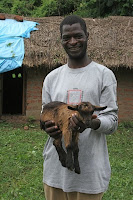Friday, January 16th
The next morning, after breakfast we gathered in the hospital chapel for devotions with the staff, then broke into groups, visiting the hospital wards to sing hymns and pray with the people there. I joined the group that visited the pediatric ward. A small child was recovering from recent surgery, and I discovered that there were six snake bite victims in the ward.
-67.jpg)
As the pieces of the puzzle began to come together for me, I realized that even that, the number of snake-bites to children sleeping in what should have been the protection of the family hut, was evidence of the disintegration and decline in the area. I remembered then, why many of the villages I had seen had seemed so different to what I had remembered.
Traditionally, the village ground around the huts was kept clear of vegetation and swept clean each day. Now, the weakness of the people, perhaps compounded by the lethargy of despondency, had allowed the grass to grow right up to the huts.
As a result, cobras and night adders looking for rodents and toads in the vicinity of human habitation were entering the huts of the sleeping families. Thankfully, quick treatment and care at the hospital was bringing healing to the swollen hands and feet of the children who had been bitten.
-70.jpg)
After meeting with a group of HIV/AIDS counselors and chaplains entrusted with the spiritual care of those coming to terms with the virus, we were taken to see the goat project.
This scheme is the vision of Sister Dorothy, a registered nurse who has lived and served at Karanda Hospital for twenty seven years. Dorothy comes from the west of the country where goats are kept for milk as well as meat. The local non-existence of infant formula or powdered milk was putting infants of HIV positive mothers at risk, so Dorothy introduced the concept of goat milk, and the care and milking of goats into the equation.
What we were shown was the result to date. The plan is to teach HIV positive mothers and mothers of malnourished infants in the care and technique of keeping goats for milk. Once mother and child are ready to return to the village, they are given a nanny goat with young at heel. To date four goats have been given and the program seems to be being successful in spite of the traditional distain of the Shona people toward tending and milking goats.
-77.jpg) Chaplain Stephen then escorted our group to visit some HIV/AIDS-related villages in the surrounding area. In each of these villages, we were escorted into the cooking hut, where we sat on mud benches around the perimeter. In each case, the people who received us would sit on the floor on the far side of the central cooking fire and we would talk, hear their story and pray together. Then, after having made our way back to the vehicle, each family we visited were given food packs. We visited with an HIV positive mother and her children first.
Chaplain Stephen then escorted our group to visit some HIV/AIDS-related villages in the surrounding area. In each of these villages, we were escorted into the cooking hut, where we sat on mud benches around the perimeter. In each case, the people who received us would sit on the floor on the far side of the central cooking fire and we would talk, hear their story and pray together. Then, after having made our way back to the vehicle, each family we visited were given food packs. We visited with an HIV positive mother and her children first.The next village we visited was an adolescent-led home, where both parents had died as a result of AIDS. We learned that each village like that was under the care of the local church congregation and, with the aid of donor churches from the west, were being assisted with food and farming advise. The contingent from a church in North Carolina who were traveling with us had been there before, and were already engaged in effectively contributing to the over-all program.
-100.jpg)






No comments:
Post a Comment